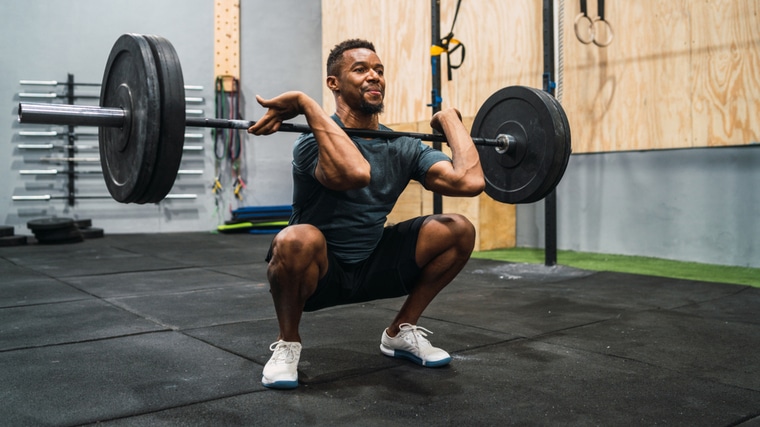You get 24 hours every day. They’re yours to do whatever you want or, more accurately, whatever you need to get done. Once you start subtracting six or seven hours of sleep, eight or nine hours of work, commuting and traveling, time to eat, and, oh yeah, some face time (not FaceTime) with your family, … Read more
The post 20-Minute Workouts for Muscle, Fat Loss, Strength, and More appeared first on Breaking Muscle.
You get 24 hours every day. They’re yours to do whatever you want or, more accurately, whatever you need to get done. Once you start subtracting six or seven hours of sleep, eight or nine hours of work, commuting and traveling, time to eat, and, oh yeah, some face time (not FaceTime) with your family, it can be difficult to squeeze in the gym.

Sure, some people shuffle priorities to find two or more hours per day to train, but for the time-constrained lifter, finding just one hour can be too big a task. Fortunately, short workouts don’t have to mean coming up short on results. Here’s how to make the most from just 20 minutes of well-planned training.
20-Minute Workouts
20-Minute Workout for Strength
Building strength and power doesn’t require a variety of exercises to hit target muscles from multiple angles. It just requires laser-like focus on some basic movements.
This straightforward approach makes this an ideal goal for brief workouts. Heavy weight, low volume training has been shown to deliver better strength gains than higher volume training. (1) Get in, get some heavy reps on a big lift, then get out to start resting and recovering.
One-Lift Workout
This focused workout requires you to put all your strength-building eggs in one basket. Choose one multi-joint (compound) barbell exercise, like the deadlift or bench press, and work on it for the entire session. Even though there’s a time limit, take three full minutes of rest between each set.

It’s going to feel like you’re spending more time resting than lifting during this workout because, well, you are. This type of long rest period has been shown to help optimize strength gains and recovery between sets. (2) This will help you make the most of the lifting you do perform. Use an extremely challenging weight without reaching muscular failure.
While this program delivers results, any extremely minimalist training plan is unsuitable for long-term programming because muscle discrepancies and imbalances may potentially develop from limited exercise options. Use this approach as needed, not as an extended long-term solution.
Deadlift
- How to Do it: Set up in front of a barbell with your feet roughly shoulder-width apart and the bar nearly touching your shins. Keep a neutral spine as you grab the bar with a palms-down grip. Pull your shoulder-blades back and open your chest. Keep your arms locked straight as you drive through your heels to stand upright. Squeeze your glutes and abs as you reach the top position. Lower the bar quickly but under control. Pause to reset your grip before performing the next repetition.
- Sets and Reps: 5 x 2
- Rest time: Three minutes between sets.
20-Minute Workout for Muscle
Muscle-building workouts can certainly benefit from multiple exercises per body part and high volume training that requires an hour or two in the gym. However, that’s absolutely not the only way to stimulate growth.
You can keep the training volume low (and, therefore, keep the workouts brief) when you manipulate exercise intensity, reach muscular failure, and even tiptoe beyond failure. This allows you to trigger muscle gains comparable to a high volume approach. (3)
Classic High-Intensity Training
Take a page out of old school bodybuilding and apply some intensity-boosting techniques to reap maximum benefit from just one high-intensity set of an exercise. It’s essential that you warm-up sufficiently, but you only have one working set to get through and there will be some serious muscle burning, so watch the foul language when you’re in the gym.

Here’s a sample plan for a chest, shoulders, and triceps workout. You can apply the same framework to any muscle group or training split — training one or two exercises per body part with one work set using intensity-boosting techniques.
Low Incline Dumbbell Press
- How to Do it: Lie on an incline bench set at a relatively low angle. Keep a palms-down grip while pressing the dumbbells from shoulder-height to meet above your chest. On each rep, pause for three seconds in the stretched position. When muscular failure approaches after eight to 10 reps, remove the pause and perform reps until muscular failure.
- Sets and Reps: 1 x 8-10, followed by as many reps as possible.
- Rest time: 90 seconds before moving to the next exercise.
Pec-Deck Flye
- How to Do it: Sit in a pec-deck machine and grab the handles at shoulder-height. Keep your elbows in line with your shoulders as you squeeze your hands to meet in the middle. Take four seconds to lower the weight on each rep. When muscular failure approaches after 10 to 12 reps, take one second to lower the weight and perform reps until muscular failure.
- Sets and Reps: 1 x 10-12, followed by as many reps as possible.
- Rest time: 90 seconds before moving to the next exercise.
Lateral Raise
- How to Do it: Stand upright with dumbbells in each hand at your side. Perform a standard lateral raise by lifting the weights to shoulder-level while keeping a slight bend in your elbows and your palms pointed down. Hold the top position of each rep for two seconds. After reaching muscular failure, immediately reduce the weight by roughly 50% and perform reps until you reach muscular failure again.
- Sets and Reps: 1 x 10-12, followed by one drop set for as many reps as possible.
- Rest time: 90 seconds before moving to the next exercise.
Triceps Pushdown
- How to Do it: Setup at a high-pulley cable station with a rope handle or EZ-bar attached. Perform a standard triceps pushdown, keeping your elbows pinned to your sides while straightening your arms. After reaching muscular failure in 10-15 reps, immediately reduce the weight by roughly 50% and perform as many reps as possible. After reaching failure again, reduce the weight a second time and perform more reps. Repeat the process until you’ve reached the lightest weight on the stack.
- Sets and Reps: 1 x 10-15, followed by multiple drop sets for as many reps as possible.
- Rest time: No rest between drop sets.
20-Minute Workout for Fat Loss
Fat loss training doesn’t have to mean marathon-like slogs on the treadmill or lightweight high-rep weight lifting.
Banging out a fast, intense workout can help to burn calories, stimulate your metabolism, and preserve muscle to reveal the lean body you’re after.
Fat-Burning Barbell Complex
A “complex” is essentially a type of circuit training where multiple exercises are performed back-to-back-to-back with a single piece of exercise equipment and a single weight. For example, you might use a 75-pound barbell for five different exercises performed in sequence without changing the weight for each exercise.

Complexes are a very efficient way to perform multiple sets of multiple movements in minimum time. Always aim to perform each repetition quickly without sacrificing technique. Because of the fast-pace and overall intensity, don’t be surprised by the relatively light weight you’ll be using. The sets shouldn’t approach muscular failure, but your cardiovascular conditioning will quickly become the limiting factor and that light weight will feel heavy enough by the end of the session.
Deadlift
- How to Do it: Set up in front of a barbell with your feet roughly shoulder-width apart and the bar nearly touching your shins. Keep a neutral spine as you grab the bar with a palms-down grip. Pull your shoulder-blades back and open your chest. Keep your arms locked straight as you drive through your heels to stand upright. Squeeze your glutes and abs as you reach the top position. Avoid bouncing the weight off the floor between reps.
- Sets and Reps: 5 x 6
- Rest time: No rest before moving to the next exercise.
Barbell Row
- How to Do it: From the top position of a deadlift, push your glutes back and bend forward at the waist. Keep a palms-down grip on the bar as your arms extend down to stretch. Maintain a neutral spine while you row the bar into your lower abs.
- Sets and Reps: 5 x 6
- Rest time: No rest before moving to the next exercise.
Hang Clean
- How to Do it: Stand upright with a palms-down grip on the bar, holding the bar in front of your hips. Push your glutes back while bending your knees slightly. Keep a neutral spine as you explode upwards with your legs to drive the bar towards the front of your shoulders. Allow your elbows to “flip” under the bar as you catch it in the top position. Drop the weight back to hip-height and perform the next rep.
- Sets and Reps: 5 x 6
- Rest time: No rest before moving to the next exercise.
Thruster
- How to Do it: This is a hybrid front squat/shoulder press movement. Hold the bar across the fronts of your shoulders as you squat down as deep as possible, as if performing a front squat. As you rise into the standing position, perform a shoulder press to lockout the bar overhead. Lower the bar to your shoulders and descend into another deep front squat. On the last rep of each set, carefully lower the bar behind your neck to rest on your traps.
- Sets and Reps: 5 x 6
- Rest time: No rest before moving to the next exercise.
Reverse Lunge
- How to Do it: Hold the bar across your traps and upper back. Step backwards with one leg and descend into a lunge position. Keep your shoulders back and your torso upright. Alternate legs each rep to perform a total of six repetitions.
- Sets and Reps: 5 x 3 per leg.
- Rest time: Rest 60 seconds before repeating the first exercise.
20-Minute Bodyweight Workout
When your schedule is tight, performing a bodyweight workout will always be an appealing and effective option.
Bodyweight training can be done anywhere and anytime, so the need to drive to and from a gym is completely eliminated and you don’t need to fight any crowds for equipment.
EMOM Bodyweight Workout
Get the most from limited training time with an EMOM workout — performing a set every minute on the minute instead of performing a set, resting a certain amount of time, and performing another set. This method lets you squeeze more training volume into a predetermined amount of time.
View this post on Instagram
This specific bodyweight workout cranks up the intensity by also incorporating supersets to fit even more work into each time period. For the duration, you’ll perform two exercises back-to-back and rest for the remainder of a minute before repeating the exercises.
T-Push-Up
- How to Do it: Begin in a push-up position with a straight line from your heels to your neck. Lower your body to the ground and straighten your arms. From the top position, shift your weight onto one hand and rotate at the shoulder. Your weight should be supported on one hand and one foot while you face sideways. Reach your free arm to the ceiling and don’t allow your hips to sink. Lower yourself under control and return to the push-up position. Perform another push-up and rotate onto the opposite hand.
- Sets and Reps: 3 reps per side, 12 minutes total.
- Rest time: No rest before moving to the next exercise.
Reverse Lunge
- How to Do it: Pull your shoulders back and keep your torso upright. Step backwards with one leg and descend into a lunge position. Perform all reps with one leg before switching sides.
- Sets and Reps: 3 reps per leg, 12 minutes total.
- Rest time: Rest until the next minute begins and then repeat the previous exercise (Note: this is not the same as resting one minute).
V-Up
- How to Do it: Lie flat on the ground with your legs straight and your hands by your sides. Keep your legs straight while raising both feet towards the ceiling and reaching both hands towards your feet. Lower your hands and legs under control. Don’t bounce your heels off the ground between reps.
- Sets and Reps: 10 reps, five minutes total.
- Rest time: No rest before moving to the next exercise.
Squat
- How to Do it: Stand with your feet more than shoulder-width apart. Keep your upper body upright as you descend into a deep squat. On the last rep of each set, hold the bottom position for five seconds.
- Sets and Reps: 5 reps, five minutes total.
- Rest time: Rest until the next minute begins and then repeat the previous exercise.
Never Skip the Warm-Up
Just because you don’t have much time to train is no excuse to skimp on a thorough warm-up. Warm-ups are an effective way to reduce the risk of injuries and improve performance. (4)(5)

If you think it’s hard to find time to get to the gym, keep skipping your warm-up and then try finding time to get to physical therapy. Or just be sure to implement a general warm-up followed by some exercise-specific movements for your training day. That’s a much better idea.
Quick and Complete Warm-up
- Squat: Stand with your feet more than shoulder-width apart. Keep your upper body upright as you descend into a squat. Adjust your depth based on your mobility and comfort. Aim to squat progressively deeper as the warm-up continues. Perform 10 reps before moving to the next exercise.
- Band Pull-Apart: Take a resistance band with a palms-down grip and hold the band at arms-length in front of you. Pull both hands back until the band touches your chest. Hold the contraction for two seconds. Return to the starting position under control. Perform 10 reps before moving to the next exercise.
- Side Lunge to High Knee: Stand with your feet together. Take a wide step to the side with one leg to the side and keep it straight as you bend the other leg. Stand upright and bring the far leg in to your center, raising the knee to waist-height before returning your feet together. Perform three reps with one leg, followed by three reps with the other leg, before moving to the next exercise.
- Push-Up Plus: Perform a basic push-up, supporting your body weight on your hands and toes. Don’t allow your hips to sag down or arch high up. With your arms locked out in the top position of each rep, continue driving your hands into the ground while spreading your shoulder blades apart. Perform five repetitions before repeating the first exercise. Perform two to four total sets of the entire circuit.
Time Enough at Last
Whether it’s busy season at the office or you just can’t find the energy to grind through a long training session, you don’t have to compromise results just because you’re grabbing a quick workout. If you can maintain focus for the duration of your average sitcom (minus commercials), you can not only stay on track, but you can keep the results rolling in.
References
-
Mangine, G. T., Hoffman, J. R., Gonzalez, A. M., Townsend, J. R., Wells, A. J., Jajtner, A. R., Beyer, K. S., Boone, C. H., Miramonti, A. A., Wang, R., LaMonica, M. B., Fukuda, D. H., Ratamess, N. A., & Stout, J. R. (2015). The effect of training volume and intensity on improvements in muscular strength and size in resistance-trained men. Physiological reports, 3(8), e12472. https://doi.org/10.14814/phy2.12472
- de Salles, B. F., Simão, R., Miranda, F., Novaes, J., Lemos, A., & Willardson, J. M. (2009). Rest interval between sets in strength training. Sports medicine (Auckland, N.Z.), 39(9), 765–777. https://doi.org/10.2165/11315230-000000000-00000
- Wernbom, M., Augustsson, J., & Thomeé, R. (2007). The influence of frequency, intensity, volume and mode of strength training on whole muscle cross-sectional area in humans. Sports medicine (Auckland, N.Z.), 37(3), 225–264. https://doi.org/10.2165/00007256-200737030-00004
- Woods, K., Bishop, P., & Jones, E. (2007). Warm-up and stretching in the prevention of muscular injury. Sports medicine (Auckland, N.Z.), 37(12), 1089–1099. https://doi.org/10.2165/00007256-200737120-00006
- Fradkin, A. J., Zazryn, T. R., & Smoliga, J. M. (2010). Effects of warming-up on physical performance: a systematic review with meta-analysis. Journal of strength and conditioning research, 24(1), 140–148. https://doi.org/10.1519/JSC.0b013e3181c643a0
Featured Image: UfaBizPhoto / Shutterstock
The post 20-Minute Workouts for Muscle, Fat Loss, Strength, and More appeared first on Breaking Muscle.







